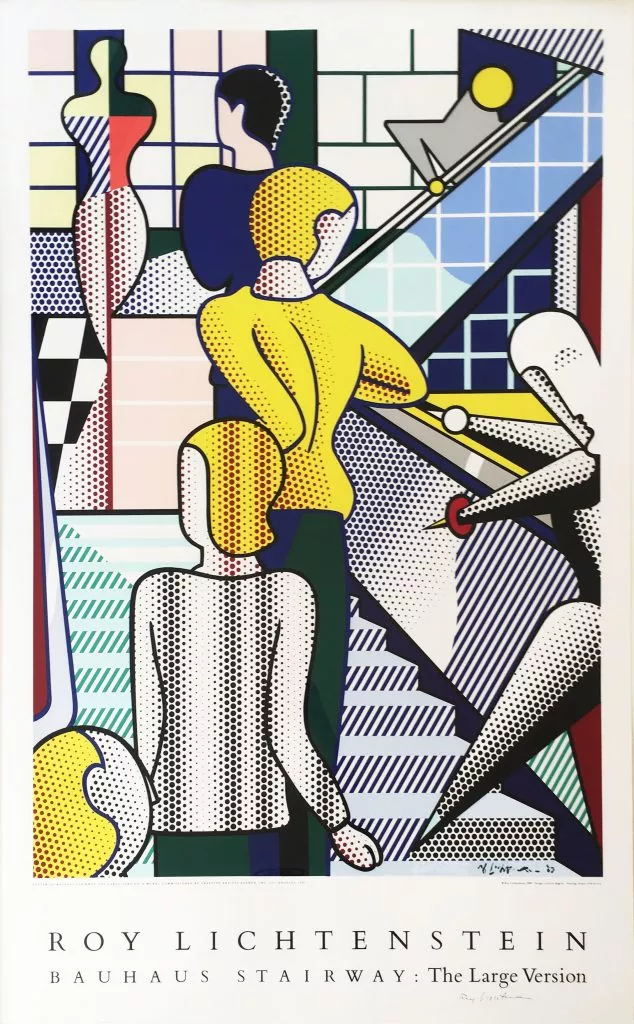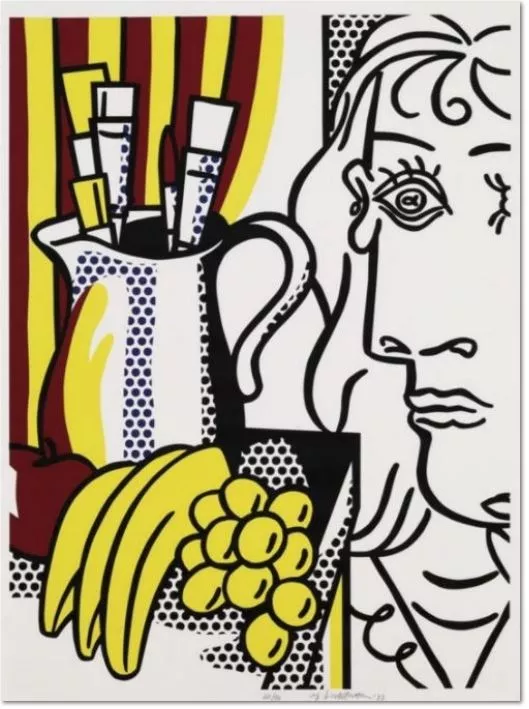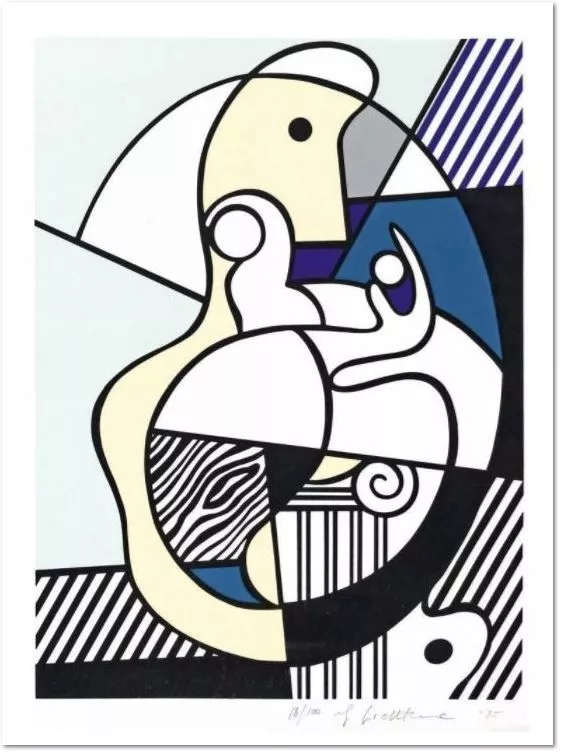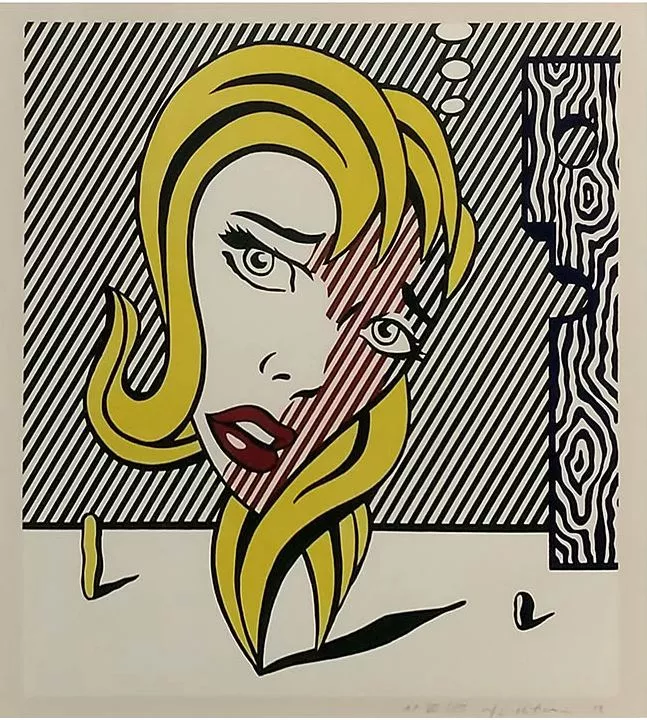 Roy Lichtenstein: “Bauhaus Stairway (After Oskar Schlemmer), The Large Version”,1989, Silkscreen poster, signed, size image: 49 1/2 x 31 in, total size with frame: 52 3/4 x 34 in. SOLD.
Roy Lichtenstein: “Bauhaus Stairway (After Oskar Schlemmer), The Large Version”,1989, Silkscreen poster, signed, size image: 49 1/2 x 31 in, total size with frame: 52 3/4 x 34 in. SOLD.
About this Artwork
The first topics that brought Lichtenstein’s work to public attention was appropriated from comic strips, but his later themes owed their visual syntax to themes from “high” culture, particularly the history of modern art. Illustrated here are examples of his interpretations of German Expressionism and Art Deco, as well as the time-honored motif of landscape in art. In every case, his sense of irony is coupled with a strikingly positive spirit. Lichtenstein extended his source material to art history, including the work of Claude Monet and Pablo Picasso, and experimented with three-dimensional works. During a trip to Los Angeles in 1978, Lichtenstein became fascinated by lawyer Robert Gore Rifkind’s collection of German Expressionist prints and illustrated books, and in 1980 began exploring the Expressionist stylistic vocabulary in paintings such as The White Tree, which evokes the lyricism of Der Blaue Reiter landscapes, and Expressionist Head that mimics Erich Heckel’s 1919 woodcut, Portrait of a Man. Lichtenstein also created a number of small pencil drawings that he used as templates for woodcuts, a medium favoured by Emile Nolde and Max Pechstein among other Expressionist artists. The culmination of this exploration was theExpressionist Woodcut Series, 1980. This set of seven woodcuts includes motifs that echo the Expressionist masterpieces, such as Dr. Waldmann, which recalls Otto Dix’s Dr. Mayer-Hermann, 1926, and Reclining Nude: an addition to Lichtenstein’s repertoire of iconography that had hitherto excluded nude figures. Lichtenstein’s use of appropriated imagery has influenced artists such as Richard Prince, Jeff Koons, and Raymond Pettibon. It’s all about art about art.
About Roy Lichtenstein
Roy Lichtenstein was born in 1923, in New York City. In 1939 he studied under Reginald Marsh at the Art Students League in New York, and the following year under Hoyt L. Sherman at the School of Fine Arts at Ohio State University, Columbus. He obtained an M.F.A. in 1949. In 1951 the Carlebach Gallery, New York, organized a solo exhibition of his semi-abstract paintings of the Old West. Shortly thereafter, the artist moved to Cleveland, where he continued painting while working as an engineering draftsman to support his growing family. In 1961 he began to make paintings consisting exclusively of comic-strip figures, and introduced his Benday-dot grounds, lettering, and balloons; he also started cropping images from advertisements. From 1964 and into the next decade he successively depicted stylized landscapes, consumer-product packaging, adaptations of paintings by famous artists, geometric elements from Art Deco design (in the Modern series), parodies of the Abstract Expressionists’ style (in the Brushstrokes series), and explosions. They all underlined the contradictions of representing three dimensions on a flat surface. In the early 1970s he explored this formal question further with his abstract Mirrors and Entablatures series. From 1974 through the 1980s he probed another long-standing issue: the concept of artistic style. Lichtenstein continued to question the role of style in consumer culture in his 1990s series Interiors, which included images of his own works as decorative elements. Lichtenstein participated in the Venice Biennale in 1966, and was honored with solo exhibitions in 1967 and 1968 at the Pasadena Art Museum and the Solomon R. Guggenheim Museum, New York, respectively. The artist was the subject of a major retrospective at the Guggenheim in 1994, three years before his death on September 30, 1997.
More Artworks by Roy Lichtenstein
Roy Lichtenstein: ‘Tel Aviv Museum Print (Cortlett 238)’, 1989, Lithograph on Rives BFK paper, edition of 60, signed and dated “rf Lichtenstein ’89” in pencil lower right, numbered, size: 26 1/4 × 56 1/2 in, 66.7 × 143.5 cm. Printed by Tyler Graphics Ltd. Literature: M. Corlett, The Prints of Roy Lichtenstein: A Catalogue Raisonne 1948-1993, New York, 1994, no. 238 another impression reproduced in color.SOLD.
Roy Lichtenstein: ‘Homage to Max Ernst’, 1975, Screenprint on Arches 88 paper, from ‘Bonjour Max Ernst portfolio’, hand-signed, dated and numbered in pencil, from the edition printed by Tyler Graphics, Mt. Kisco, NY of 100 with the printer’s blind stamp, size: 25 15/16 x 20 (66 x 50.8 cm).Price upon request.
Roy Lichtenstein: ‘Blonde’, 1978, Lithograph on Arches paper, from the Surrealist Series (C.153), signed, numbered, and dated in pencil, lower right, image Size: 21.75 x 19.125 in, total size: 29.75 x 27 in. We offer one of the E.A. This artwork is in excellent condition.Price upon request.
 Roy Lichtenstein: ‘Still Life with Picasso’, 1973, serigraph on velin, size: 75.8 x 56 cm, signed, dated and numbered, edition 60/90. Printed by Gemini G.E.L., Los Angeles. Published in the portfolio: ‘Hommage à Picasso’, Folder 4, Propyläen Verlag, Berlin and Panthéon Press, Rome 1973/1974.Price upon request.
Roy Lichtenstein: ‘Still Life with Picasso’, 1973, serigraph on velin, size: 75.8 x 56 cm, signed, dated and numbered, edition 60/90. Printed by Gemini G.E.L., Los Angeles. Published in the portfolio: ‘Hommage à Picasso’, Folder 4, Propyläen Verlag, Berlin and Panthéon Press, Rome 1973/1974.Price upon request.



